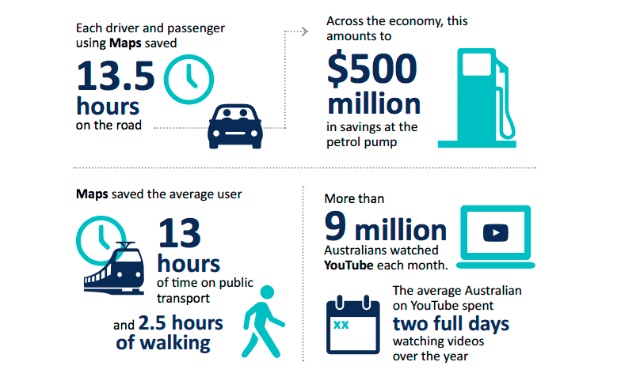 |
| A Google Map of Melbourne with traffic data. |
So we asked experts at AlphaBeta to look into the economic contribution of free digital tools like Google Maps to Australia and the numbers they came back with are striking.
AlphaBeta estimates that:
- Google Maps contributes $4.3 billion to the Australian economy each year
- 11 million drivers and passengers across Australia (almost half the nation’s population) rely on Google Maps to get them from A to B each day
- Australians saved approximately 13.5 hours each on the road in 2015 — that’s more than half a day less of driving in circles!
 |
| Source: AlphaBeta 'Google Economic Impact Australia 2015' |
It’s not just drivers who benefit either. By helping people plan their public transport journeys, Google Maps saved 9.8 million Australians 13 hours each over the course of a year. That’s 46,800 seconds not on the bus. And the 5 million Aussies that use Maps for walking saved about 2.5 hours.
 |
| Source: AlphaBeta 'Google Economic Impact Australia 2015' |
Google Maps now has more than a billion users worldwide, is free of charge and allows you to quickly pinpoint the places and information you need, whether it's how many minutes until the next bus arrives, or how long it will take to walk or bike from work to home.
Globally, about a fifth of all Google searches - and a third of those from mobile phones - are location-related. In Australia people use Google Maps to find the best route and quickly locate a new destination, such as a friend’s house, restaurant, or national park. And Google Maps helps make that trip as hassle-free as possible by picking the quickest public transport route or the best driving route based on traffic conditions. That means less time on the road, less time on the train platform.
These savings have economic benefits and they also have a big social impact - we all know the difference getting home from work 15 minutes earlier can make to your leisure and family time. Chances are you’re already using Google Maps to get to that meeting or to plan your trip home - and we’re constantly improving it, recently adding an Australian voice to directions and (finally!) giving Melbournians some public transport directions. So the benefits of Maps might not be news to you, but their value to the economy might come as a surprise. You can read the full report from AlphaBeta here.